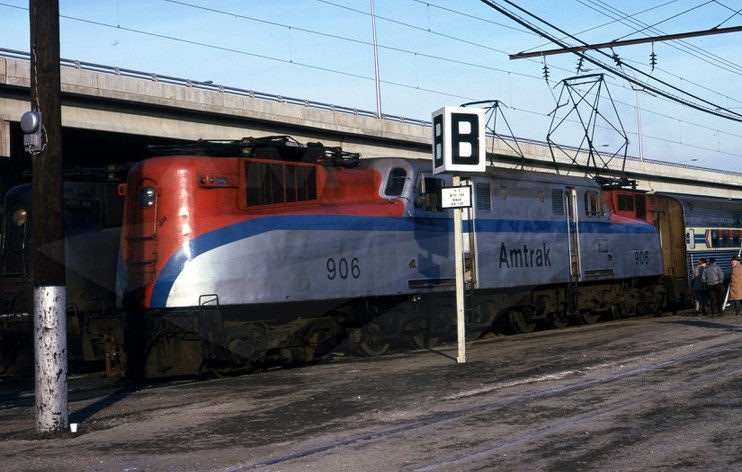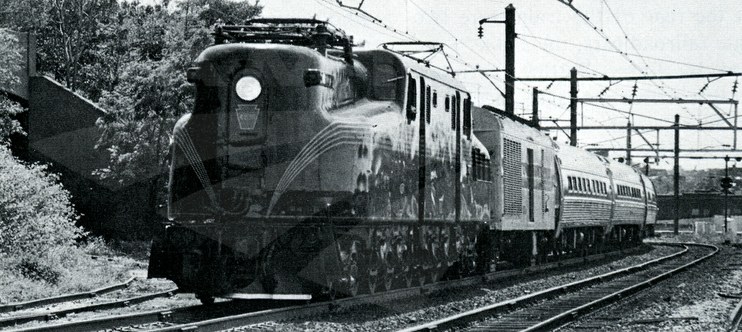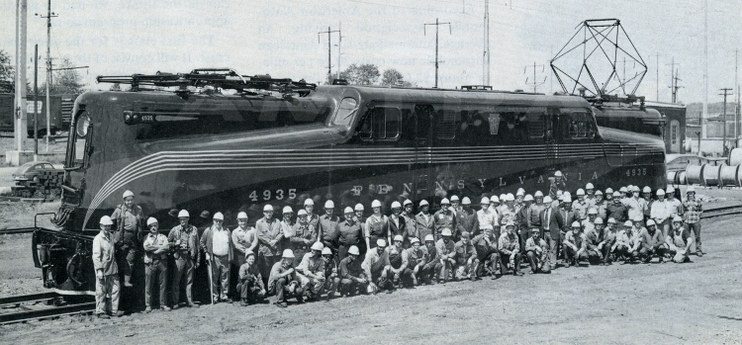Digging into the Archives: The Amazing GG-1 Locomotive
CommentsJune 20, 2013
In a May 2013 ceremony held at the Siemens rail manufacturing plant in Sacramento, Calif., Amtrak unveiled the first of 70 new Cities Sprinter locomotives (ACS-64) ordered for use on the Northeast Corridor (NEC) between Washington and Boston and the Keystone Corridor between Philadelphia and Harrisburg. The ACS-64 will be the latest in a long line of distinguished electric locomotives, such as the GG-1 and AEM-7, that have carried passengers in the Northeast since large sections of the rail corridor were electrified in the 1930s.
Once tested at the U.S. Department of Transportation facility in Pueblo, Colo. and on the NEC, the first ACS-64s will enter service later this year. Production will then continue through 2016 so that the existing fleet of AEM-7 locomotives, introduced between 1980 and 1988, can be retired. Parts for the new locomotives come from approximately 60 suppliers in more than 20 states.
The new Amtrak Cities Sprinter locomotives unveiled at the
Siemens plant in Sacramento, Calif.
Designed to run at speeds up to 125 mph, the dual-cab Cities Sprinters have a peak 8600 horsepower. A regenerative braking system can feed up to 100 percent of the energy generated during braking back to the power grid. Safety is paramount with enhanced crash energy management components such as crumple zones, while a microprocessor system allows for self-diagnosis of technical issues. Ultimately, this improved technology leads to a more energy efficient locomotive fleet and significant cost savings.
The Cities Sprinter locomotives are an integral component of the long-term Amtrak Fleet Strategy Plan to modernize and expand the railroad’s pool of locomotives and rolling stock. Concurrently, CAF USA is building 130 new single-level long-distance cars at its facility in Elmira, N.Y. This order includes sleepers, diners, baggage cars and baggage/dormitory cars that will replace and supplement the existing fleet, of which the oldest Heritage cars date to the 1940s.
To celebrate the introduction of the Amtrak Cities Sprinter—destined to be the new “workhorse” of the NEC—we thought it would be interesting to dig into the archives and look at its predecessors, starting with the famed GG-1.
The electric GG-1 locomotives were originally commissioned by the Pennsylvania Railroad (PRR) in the 1930s for use on its newly electrified Washington-New York and Philadelphia-Harrisburg rail corridors. Electric locomotives could accelerate more quickly than steam locomotives and hauled longer, heavier trains. Investigating its options, the PRR borrowed an electric locomotive built by General Electric for the New York, New Haven and Hartford Railroad and liked it so much that it was used as a model for the GG-1.
By 1934, the PRR, in partnership with General Electric, Westinghouse and Baldwin Locomotive Works, had designed and constructed the first of a total 139 GG-1s. Featuring a dual cab design, the locomotive could easily operate in either direction, thereby avoiding turn-around time at the end of a run. The central placement of the cabs also provided greater safety for the crew in the event of a collision. The locomotive body, supported by two trusses, contained an oil-fired steam boiler to provide heating for the cars, while a transformer converted the 11,000 volt electrical current drawn from the catenary wires to a 600 volt level suitable for the traction motors and other components. Pantographs, which conduct the electrical current from the catenary wire, were located at both ends of the locomotive.
Weighing in at 238 tons, the GG-1 had 12 motors that regularly produced 4620 horsepower, but which could be pushed to a maximum of 8500. In testing, the first GG-1—#4800—hit a top speed of 128 mph, but in regular service they were kept to speeds of 100 mph and lower. Each unit measured roughly 79.5 feet long, 10.5 feet wide and 15 feet high.

Amtrak GG-1 No. 906 in a patriotic Amtrak livery.
The General Electric-designed GG-1 prototype edged out a competing Westinghouse model due to its superior suspension system. According to a brochure produced by the American Society of Mechanical Engineers, “The GG-1 equalization and suspension system provided a ‘dual tripod’ arrangement that insured equal static load on all driving wheels, regardless of track irregularities and curvature.”
Once the prototype was completed, the PRR called on industrial designer Raymond Loewy to finesse the GG-1’s overall appearance. In keeping with the prevailing trend towards a streamlined aesthetic emphasizing speed and movement, Loewy urged that the body be welded together rather than riveted and that the corners be rounded to produce a clean, sleek surface. Even the locomotive bell—a prime source of communication on the railroad—was hidden inside the body to maintain the GG-1’s pleasing lines.
Loewy also introduced a paint scheme that paired a gleaming, rich Brunswick Green body with five parallel gold pinstripes on the sides. At each end, the lines merged at the base of the hood, leading rail enthusiasts to refer to them as “cat’s whiskers.” The sides also included the railroad’s name flanked by the unit number.
When Amtrak began operations in 1971, the GG-1s were still in service after more than three decades. Following the merger of the PRR and New York Central Railroad in 1968, they had come under the control of the resulting company, known as Penn Central. Well built and reliable, the GG-1s were then used by Amtrak to pull trains between Washington and New York. Amtrak purchased 30 GG-1s and leased an additional two dozen; on the Northeast Corridor, they operated at speeds up to 100 mph. During the late 1970s, while the high-speed Metroliner cars underwent rebuilding, GG-1s were used in this premium service.
Paint schemes varied for the Amtrak GG-1s. The cover of a 1973 timetable issued for eastern trains featured GG-1 #4931 in a three color livery with a silver body, red hood and single blue stripes on each side in place of Loewy’s “cat's whiskers.” Much like the PRR scheme, “Amtrak” flanked by the unit number was centrally positioned on the sides. Other units were painted a simple black with white lettering.
Approaching its fifth decade of service, Amtrak finally retired its GG-1 fleet as the new high-speed, lightweight AEM-7 locomotives were put into service starting in 1980. The last Amtrak GG-1 ran on May 1, 1981—ten years to the day when Amtrak took over the nation’s intercity passenger rail system. New Jersey Transit continued to use GG-1s until 1983—almost fifty years after the first one was produced. On the NEC, GG-1s were also used in freight service by the PRR, Penn Central and their successor, Conrail, until 1979.
Long acknowledged as some of the finest electric locomotives ever built, the GG-1s gained a long list of admirers while still in operation. The June 1, 1977 issue of Amtrak NEWS relates the story of the “Friends of the GG-1,” a group of rail fans that raised funds to restore Amtrak-owned GG-1 #4935 to the original PRR paint scheme. Refurbishment was undertaken at the Wilmington, Del. maintenance facility.

The restored Amtrak GG-1 #4935 leads the Murray Hill
from Washington to New York City.
The engine went into revenue service on May 15th when it led the Murray Hill between Washington and New York. On hand for the inaugural run were Amtrak President and CEO Paul Reistrup and designer Raymond Loewy. Reflecting on his original paint scheme, Loewy said: “[It gave the locomotive] a graceful expression of silent speed and power…It looks like it’s moving when it’s standing still.”
Prized pieces of railroad history, GG-1s are today found in museums across the country. Amtrak passengers aboard the Keystone Service or Pennsylvanian can catch a glimpse of GG-1 #4859 at the historic Harrisburg Transportation Center. Listed on the National Register of Historic Places, it is also the “official” electric locomotive of the Commonwealth of Pennsylvania. Number 4859, built in 1937, pulled the first electrically powered train between Philadelphia and Harrisburg on January 15, 1938. The Harrisburg Chapter of the National Railway Historical Society maintains the locomotive for the enjoyment of the public.






